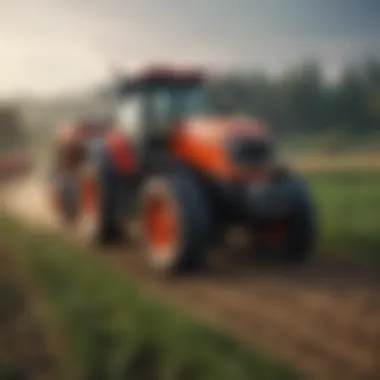Unveiling the Agricultural Revolution: Tractor Simulator Innovations


Introduction
In the realm of modern agriculture, a groundbreaking revolution is underway, driven by the integration of advanced technologies like farming tractor simulators. These cutting-edge tools are not only reshaping traditional farming practices but also redefining the way farmers train, operate, and achieve efficiency in the field. This article delves deep into the transformative impact of tractor simulators on the agricultural industry, uncovering a myriad of benefits and applications that pave the way for a new era in farming.
Advancements in Training Methods
One of the key pillars of change brought about by tractor simulators is the enhancement of training methods for farmers. By providing a simulated environment that mimics real-life field conditions, these technologies offer a hands-on learning experience that is both immersive and educational. From novice farmers looking to build their skills to seasoned professionals aiming to refine their techniques, tractor simulators play a vital role in ensuring that operators are well-prepared to handle various farm equipment and navigate complex agricultural tasks.
Simulation Capabilities
The simulation capabilities of these tractor simulators are nothing short of impressive. Users can practice operating different types of tractors, experiment with various implements, and confront diverse farming scenarios without any real-world risks. This not only facilitates skill development but also instills confidence in operators, enabling them to make informed decisions and optimize their performance in the field.
Virtual Training Environments
Moreover, the use of virtual training environments allows farmers to undergo scenario-based learning, where they can tackle challenges like soil management, crop cultivation, and equipment maintenance in a controlled setting. By offering a safe space to explore, learn, and troubleshoot, tractor simulators help in minimizing errors, reducing downtime, and ultimately maximizing productivity on the farm.
Boosting Field Efficiency
Beyond training applications, tractor simulators are instrumental in boosting field efficiency and operational effectiveness. By honing skills and improving decision-making abilities through simulation exercises, farmers can execute tasks with greater precision, speed, and resource optimization.
Precision Farming Techniques
The integration of tractor simulators with precision farming techniques further enhances efficiency by enabling operators to perform tasks with unparalleled accuracy. From seed placement to fertilizer application, every action can be fine-tuned and optimized to ensure optimal crop yield and resource utilization.
Real-Time Data Analysis
Moreover, these simulators offer real-time data analysis capabilities, allowing farmers to monitor field conditions, track performance metrics, and adjust operational strategies on the fly. By leveraging this functionality, operators can make informed decisions, identify problem areas, and implement timely interventions to maximize production output.
Reshaping Modern Farming Methods
In essence, tractor simulators are not just technological tools; they are catalysts for change in modern farming methods. By facilitating skill development, promoting efficient practices, and empowering farmers with data-driven insights, these simulations play a pivotal role in driving the agricultural industry towards a more sustainable, productive, and technologically advanced future.
Conclusion


As we navigate through the dynamic landscape of agriculture, the role of tractor simulators becomes increasingly paramount. From educating the next generation of farmers to ushering in a new era of farm management practices, these advanced technologies are poised to revolutionize the way we approach agriculture. By embracing innovation, adapting to change, and harnessing the power of tractor simulators, the agricultural industry can cultivate a brighter, more prosperous future for all stakeholders involved.
Introduction to Farming Tractor Simulator
In the rapidly evolving realm of modern agriculture, the Introduction to Farming Tractor Simulator stands as a pivotal point of discussion in this insightful article. Delving deep into the essence of this technological advancement, we unravel its profound impact on traditional farming practices. The introduction of tractor simulators has redefined the landscape of agricultural training and operational efficiency, ushering in a new era of innovation and sustainability. By immersing farmers in realistic virtual environments, these simulators revolutionize the way individuals engage with farm equipment, fostering a hands-on learning experience unparalleled in conventional settings. As we navigate through the intricacies of tractor simulation technology, we uncover the fundamental benefits and considerations that underline its significance in modern agriculture.
Evolution of Farming Technology
Traditional Farming Methods
Traditional Farming Methods constitute the bedrock of agricultural practices, embodying centuries-old techniques passed down through generations. These methods encapsulate the essence of manual labor, emphasizing the human touch in cultivating crops and tending to livestock. While labor-intensive, traditional farming methods showcase a deep-rooted connection to the land and a profound respect for nature's rhythms. The meticulous craftsmanship involved in these methods imparts a sense of tradition and authenticity to farming practices, highlighting the enduring wisdom of our agricultural forebears. However, the reliance on manual labor poses challenges in an increasingly technology-driven industry, prompting the integration of cutting-edge solutions like tractor simulators for enhanced efficiency and productivity.
Introduction of Technology in Agriculture
The Introduction of Technology in Agriculture marks a transformative shift in the way we approach farming practices, catalyzing innovation and progress across the agricultural sector. By incorporating sophisticated technological tools into traditional farming workflows, we unlock new possibilities for growth and sustainability. From automated irrigation systems to precision farming equipment, technology revolutionizes every aspect of agricultural operations, streamlining processes and maximizing output. The integration of digital advancements cultivates a dynamic environment where data-driven decisions and smart solutions drive agricultural success. While the adoption of technology in agriculture presents numerous advantages, such as increased productivity and sustainability, it also necessitates careful consideration of potential drawbacks, including high initial costs and the need for specialized training.
Role of Farming Tractor Simulator
Enhancing Training Procedures
aughs
Benefits of Using Tractor Simulators
In this comprehensive guide focusing on the benefits of using tractor simulators in revolutionizing farming practices, it is vital to understand the pivotal role these advanced technologies play in modern agriculture. Tractor simulators offer a wide array of advantages, catering to enhancing training procedures and improving operational efficiency on the field. By providing a realistic and immersive experience, tractor simulators bridge the gap between traditional training methods and modern technological advancements, setting a new standard in agricultural education and practice.
Training Advantages
Realistic Field Experience
The realism achieved through field experience simulations is a key component in the effectiveness of tractor simulators. These simulations replicate the challenges and intricacies of actual field operations, allowing users to experience different scenarios and develop practical skills in a controlled environment. The realistic feedback and scenarios presented in these simulations ensure that trainees are well-prepared to handle real-life situations, boosting their confidence and proficiency in operating farming equipment effectively.
Risk-Free Learning Environment


The provision of a risk-free learning environment is a standout feature of tractor simulators. Trainees can make mistakes and learn from them without the fear of causing actual damage to expensive machinery or crops. This hands-on learning approach cultivates a culture of continuous improvement, where individuals can refine their techniques and decision-making processes without bearing the burden of costly repercussions. The safety and controlled setting of simulator training significantly reduce the learning curve, leading to quicker skill acquisition and retention.
Operational Efficiency
Enhanced Precision
Operational efficiency is greatly enhanced through the precision capabilities of tractor simulators. Users can fine-tune their maneuvers and optimize their workflows with a level of precision that surpasses traditional farming methods. The ability to practice and perfect tasks repeatedly in a simulated environment allows for the development of muscle memory and expert-level proficiency, resulting in increased productivity and reduced margin of error during actual field operations.
Time and Cost Savings
The time and cost savings offered by tractor simulators are significant factors in their appeal to modern farmers. By streamlining training processes and minimizing downtime for equipment adjustments or repairs, simulator training translates to a more efficient use of resources and personnel. Additionally, the ability to simulate various scenarios and conditions without incurring real-world expenses provides a cost-effective solution for continuous skills development and operational readiness.
Environmental Sustainability
Optimized Resource Management
One of the key contributors to environmental sustainability in modern agriculture is optimized resource management facilitated by tractor simulators. These simulations enable farmers to fine-tune their resource allocation strategies, such as water usage, fertilizers, and energy, to minimize waste and maximize efficiency. By promoting responsible resource utilization practices, tractor simulators play a crucial role in supporting environmentally conscious farming methods that prioritize long-term sustainability and stewardship of natural resources.
Reduced Carbon Footprint
Reducing the carbon footprint of farming operations is a pressing issue that tractor simulators address effectively. By promoting energy-efficient practices and minimizing fuel consumption through optimized route planning and equipment utilization, tractor simulators contribute to mitigating the environmental impact of agricultural activities. The adoption of simulator training not only leads to operational cost savings but also aligns with global sustainability initiatives aimed at reducing greenhouse gas emissions and promoting eco-friendly farming practices.
Applications of Farming Tractor Simulators
In this section, we delve into the critical role of farming tractor simulators and their impact on modern agricultural practices. As technology advances, the use of simulators revolutionizes traditional methods by providing a simulated environment for training and operational planning. These simulators offer a realistic experience that aids in decision-making and skill development, ultimately leading to improved efficiency and productivity in farming processes.
Training and Education
Agricultural Schools and Institutes: Agricultural schools and institutes play a crucial role in educating the next generation of farmers on the utilization of farming tractor simulators. These institutions focus on imparting practical knowledge through hands-on training sessions and theoretical courses that cover various aspects of agricultural machinery operation. The unique aspect of these educational programs lies in their emphasis on real-world applications and experiential learning, preparing students for the challenges they may face on the field. While the advantages include practical skill acquisition and industry-specific training, potential drawbacks may arise from the limitation of resources and access in certain regions.
Professional Development Programs: Professional development programs cater to current farmers and industry professionals seeking to enhance their skills and adapt to new technologies like farming tractor simulators. These programs offer specialized training that aligns with the latest advancements in agricultural practices, equipping participants with the knowledge needed to optimize their farming operations. The distinct feature of such programs is their focus on customization and adaptability, allowing individuals to tailor their learning experience based on their specific requirements. The benefits include continuous skill enhancement and networking opportunities, although challenges may emerge in maintaining program relevance amidst rapidly evolving farming technologies.
Research and Development


Testing New Farming Techniques: The testing of new farming techniques using tractor simulators contributes significantly to refining agricultural practices. By simulating different scenarios, farmers and researchers can evaluate the feasibility and efficacy of innovative methods before implementing them in real-world settings. This approach assists in mitigating potential risks and uncertainties associated with adopting untested techniques, ultimately improving efficiency and productivity in farming operations. The unique feature of this process is its ability to provide data-driven insights that inform strategic decision-making, leading to sustainable agricultural practices. However, challenges may arise in replicating all environmental variables accurately within the simulation environment.
Innovative Equipment Design: Innovative equipment design, facilitated by tractor simulators, redefines the landscape of agricultural machinery by incorporating cutting-edge technologies. The key characteristic of this aspect is the seamless integration of data analytics and automation into farming equipment, enabling precise control and monitoring of operations. This advancement enhances efficiency, resource utilization, and overall yield, aligning with the industry's sustainability goals. The distinctive feature of innovative equipment design lies in its potential to revolutionize traditional farming practices by offering more ergonomic, eco-friendly, and technologically advanced solutions. Despite its advantages, challenges may present themselves in terms of initial investment costs and compatibility with existing infrastructure.
Field Operations
Precision Farming: Precision farming, supported by tractor simulators, optimizes agricultural processes by enabling precise management of resources and inputs. This method focuses on site-specific cultivation and tailored treatment approaches, enhancing crop yield, while minimizing waste and environmental impact. The key characteristic of precision farming is the utilization of data analytics and geospatial technologies to customize farming practices based on real-time data analysis. This dynamic approach allows for adaptive decision-making, promoting sustainable and efficient farming methods. However, challenges may arise in ensuring data accuracy and the seamless integration of technology across different agricultural operations.
Harvesting and Cultivation: Tractor simulators play a vital role in streamlining harvesting and cultivation processes, improving overall efficiency and output quality. By simulating harvesting and cultivation tasks, farmers can optimize logistics, reduce turnaround times, and maintain crop quality standards. The unique feature of this application is its ability to enhance operational planning and scheduling through virtual simulations that replicate field conditions. This approach leads to increased productivity and profitability, providing a competitive edge to farmers embracing this technology. However, challenges may emerge in replicating the complexity of real-world field conditions accurately and ensuring the seamless transition from simulation to actual field operations.
Future Trends in Farming Technology
Future Trends in Farming Technology play a pivotal role in driving innovation and efficiency in modern agriculture. As we delve into the integration of AI and IoT (Artificial Intelligence and Internet of Things) in farming practices, we witness a transformative shift towards more intelligent and data-driven decision-making processes. The fusion of these technologies not only enhances productivity but also revolutionizes how farmers interact with their land and crops. By leveraging AI and IoT, farmers can access real-time insights, optimize resource allocation, and make informed decisions that directly impact their yield and sustainability efforts.
Integration of AI and IoT
Smart Farming Solutions
Smart Farming Solutions, an integral part of the integration of AI and IoT in agriculture, are designed to automate and streamline various farm operations. These solutions encompass a wide range of applications, including precision agriculture, predictive analytics, and autonomous machinery. One key characteristic of Smart Farming Solutions is their ability to gather and analyze vast amounts of data efficiently, allowing farmers to optimize inputs, reduce wastage, and maximize output. The unique feature of Smart Farming Solutions lies in their adaptability to different farming environments and scales, making them a popular choice for modern farmers looking to enhance their operational efficiency and sustainability practices.
Data-Driven Decision Making
Data-Driven Decision Making is another crucial aspect of the AI and IoT integration, empowering farmers to make informed choices based on data analytics and predictive modeling. By harnessing the power of data, farmers can identify trends, mitigate risks, and fine-tune their strategies for improved outcomes. The key characteristic of Data-Driven Decision Making is its emphasis on enhancing precision and reducing uncertainties in agricultural processes. While data-driven approaches offer unparalleled insights and opportunities for optimization, they also come with challenges such as data security and privacy concerns that need to be addressed for successful implementation.
Virtual Reality in Agriculture
Virtual Reality (VR) technologies are reshaping the landscape of agricultural training and crop management. Immersive Training Environments provide farmers with realistic simulations that replicate various farming scenarios, allowing them to practice and refine their skills in a controlled setting. These environments offer a hands-on learning experience without the risks associated with actual field work, contributing to enhanced safety and proficiency among agricultural professionals. The unique feature of Immersive Training Environments is their ability to provide interactive and engaging training sessions that cater to different learning styles, making them a beneficial choice for practical skill development in the agriculture sector.
Simulated Crop Management
Simulated Crop Management software simulates crop growth cycles and management practices within a virtual environment, enabling farmers to experiment with different strategies and predict outcomes before implementing them in real fields. The key characteristic of Simulated Crop Management is its capacity to illustrate the impact of various factors such as weather conditions, soil health, and pest infestations on crop growth, allowing farmers to make more informed decisions. While this technology offers valuable insights and risk mitigation benefits, its limitations include the need for accurate data input and calibration to ensure the simulation reliability and relevance to real-world scenarios.
Global Adoption and Accessibility
The global adoption of advanced farming technologies like tractor simulators is reshaping traditional agricultural landscapes and opening up new possibilities for farmers worldwide. Small-Scale Farming Integration focuses on tailoring technological solutions to suit the needs and challenges faced by smaller agricultural operations, ensuring that all farmers can benefit from technological advancements regardless of their scale. The key characteristic of Small-Scale Farming Integration is its ability to adapt sophisticated technologies to meet the specific requirements of small-scale farmers, promoting inclusivity and sustainability in agricultural practices. While this integration offers numerous advantages in terms of efficiency and productivity, there are concerns regarding the initial investment costs and training requirements that need to be addressed to ensure widespread adoption.
Emerging Markets Expansion
Emerging Markets Expansion involves introducing advanced farming technologies to developing regions and emerging economies, where agriculture plays a crucial role in the economy and livelihoods of communities. This expansion aims to bridge the technological gap between developed and developing regions, empowering farmers with tools and knowledge to improve their yields and sustainability practices. The key characteristic of Emerging Markets Expansion is its potential to drive economic growth, alleviate poverty, and enhance food security through enhanced agricultural productivity. While the benefits of expansion are significant, challenges such as infrastructure limitations and adaptation to local contexts require careful consideration to ensure successful and sustainable integration of these technologies.



